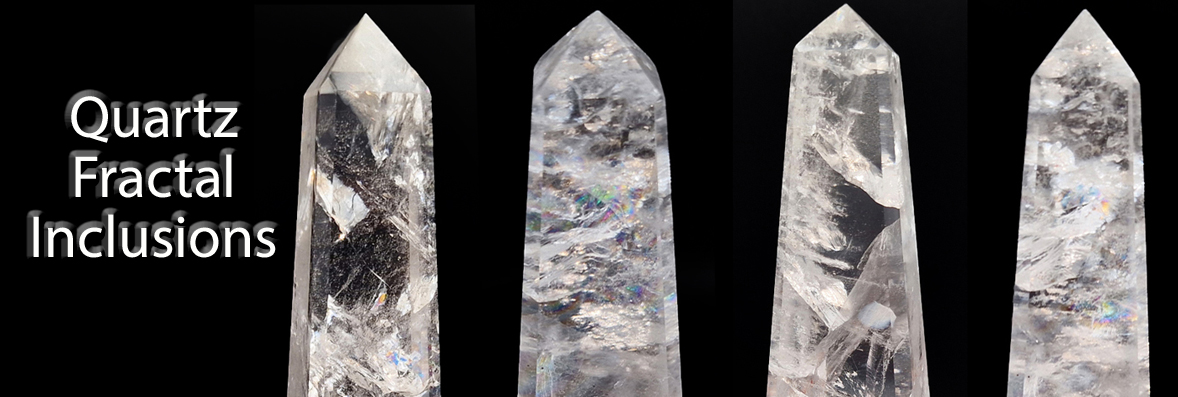
What are those cracks in the quartz crystal! Are these damage?
Answer, No these are one of the reasons you know its actually a crystal, these internal features are visual evidence of the crystals pattern of construction, and whats more, those construction patterns can be visually stunning and make that quartz crystal more distinctive
The image above is taken from some of our Brazilian Quartz obelisks, and the examples show some stunning effects inclusions can make, including revealing internal structure, the crystal lattice and in many cases, rainbows which occur from the light in the prism of the crystal.
So how do they get created?
Alright! Let’s dive into the amazing world of fractals in crystals!

You need to zoom in, in your mind to the initial crystal atom shape where the crystal first crystallized and then perpetuate that process forward.
 Imagine looking at a snowflake under a microscope. You might notice it has tiny branches, and if you zoom in, those branches have even smaller branches. And if you zoom in even more, the tiny branches have *even tinier* branches that look similar to the bigger ones. That’s what a "fractal" is! It's a shape or pattern that repeats itself on smaller and smaller scales.
Imagine looking at a snowflake under a microscope. You might notice it has tiny branches, and if you zoom in, those branches have even smaller branches. And if you zoom in even more, the tiny branches have *even tinier* branches that look similar to the bigger ones. That’s what a "fractal" is! It's a shape or pattern that repeats itself on smaller and smaller scales.
Now, crystals, like salt or quartz, can sometimes grow in similar fractal patterns. As the crystal grows, the particles line up in repeating ways, sometimes branching off like snowflakes. If we could zoom in on those crystals, we’d see smaller patterns that look like the bigger ones — a bit like magic repeating itself!
So, fractals in crystals mean that the way crystals grow and form can create tiny patterns that look just like the big pattern. It’s nature’s way of repeating a beautiful design, from the big picture all the way down to the tiniest details! That's a good starting point, now apply that to quartz its self.
Quartz is a type of crystal that forms deep inside the Earth. While it's forming, quartz often traps tiny bits of other stuff around it — like water, gas bubbles, or other minerals — inside its crystal structure. These trapped bits are called "inclusions".
Now, sometimes these inclusions arrange themselves in fractal patterns. Here’s why: as the quartz cools and hardens, it grows in layers, sort of like the way frost spreads over a window in winter. The particles around it, like water or gas, can get "pushed around" and trapped by the growing crystal. If the quartz is forming in a place where conditions keep changing, like temperature or the amount of stuff in the air or water around it, these trapped bits spread in branching, repeating patterns, just like snowflakes or frost.
So, fractal inclusions in quartz happen because the quartz crystal grows in a changing environment, and that causes the tiny bits inside it to arrange themselves in beautiful, repeating ways. It’s like nature drawing little designs inside the crystal as it grows!
Quartz Fractal inclusions are not a flaw in a crystal, not to a geologist or crystal lover, they are prized.
